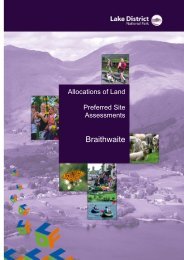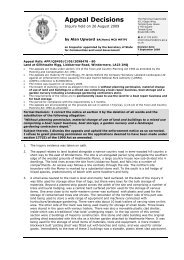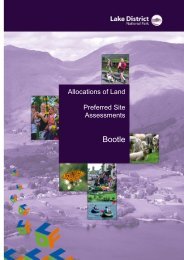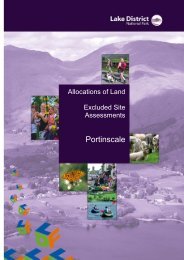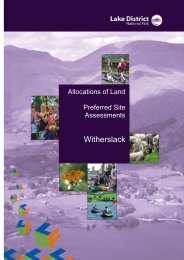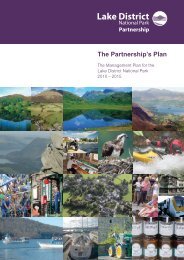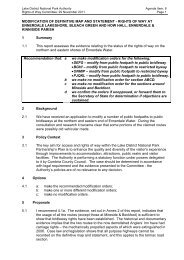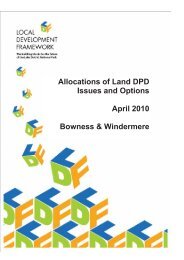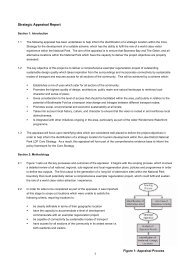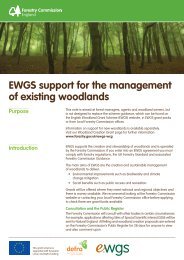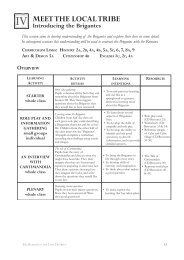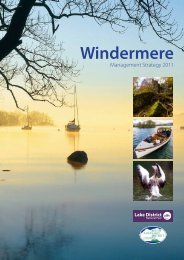Habitats - Lake District National Park
Habitats - Lake District National Park
Habitats - Lake District National Park
Create successful ePaper yourself
Turn your PDF publications into a flip-book with our unique Google optimized e-Paper software.
In contrast, lakes such as<br />
Windermere and Bassenthwaite<br />
<strong>Lake</strong> support a more diverse range<br />
of species. Their more wooded<br />
shorelines, with shallow bays and<br />
areas of reedbed, provide valuable<br />
nesting haunts for swans, grebes and<br />
other birds. Windermere is of<br />
national importance for wintering<br />
wildfowl.<br />
Bassenthwaite <strong>Lake</strong> is very rich in<br />
aquatic plants including the<br />
nationally-scarce floating water<br />
plantain, and is one of only two lakes<br />
in Britain known to support the fish<br />
vendace. Bassenthwaite <strong>Lake</strong> was<br />
designated a NNR in 1993 and is<br />
owned and managed by the <strong>National</strong><br />
<strong>Park</strong> Authority. In 2001 the first pair<br />
of ospreys to nest in northern<br />
England for 150 years, bred near the<br />
shores of Bassenthwaite <strong>Lake</strong>.<br />
Threats to the <strong>Lake</strong>shore Environment<br />
On many of the lakes and tarns<br />
recreational use can sometimes<br />
conflict with nature conservation<br />
interests. The lakeshore habitat is a<br />
fragile “soft shore” environment that<br />
is highly susceptible to erosion. The<br />
trampling action of feet, coupled<br />
with grazing by livestock and waves<br />
created from passing boats, can lead<br />
to soil and organic material being<br />
washed away. Over time, the reedy<br />
shoreline may begin to resemble a<br />
pebble beach which contains only a<br />
fraction of the invertebrate species<br />
and little or no aquatic vegetation.<br />
Erosion of a stony shore<br />
A stony shore<br />
hydrosere with<br />
all herbs and<br />
grasses …<br />
reduced by<br />
trampling to a<br />
grass sward<br />
which<br />
subsequently<br />
breaks up …<br />
leading to<br />
erosion of the<br />
surface and<br />
exposure of<br />
tree roots …<br />
This eventually<br />
results in the<br />
loss of lakeside<br />
trees and<br />
formation of a<br />
gravel beach<br />
Rivers<br />
Many of the rivers within the<br />
<strong>National</strong> <strong>Park</strong> are of considerable<br />
ecological importance. The<br />
significant populations of fish,<br />
together with other species such as<br />
native crayfish, freshwater pearl<br />
mussel and otter, reflect the<br />
generally high standards of water<br />
quality. The fast flowing upland<br />
streams provide ideal conditions for<br />
birds such as dippers and grey<br />
wagtails.<br />
Rock and Scree<br />
Glacial activity has produced a wide<br />
variety of crags, knolls, ledges and<br />
other rock features. In some places,<br />
steep sided gills cut deeply into the<br />
fellsides. These ravines provide a<br />
damp, sheltered environment and<br />
are largely inaccessible to grazing<br />
animals, which enables them to<br />
support many unusual plants.<br />
Steep rocky cliffs known locally as<br />
crags support a mosaic of plant life,<br />
with a mixture of arctic-alpine flora<br />
and lowland plant species. Sheltered<br />
rock ledges support a rich<br />
assemblage of tall herbs and ferns<br />
along with many mosses, liverworts<br />
and flowering plants. They also<br />
provide a habitat for a varied range<br />
of bird species including stonechat,<br />
wheatear and ring ouzel and nest<br />
sites for raven, peregrine and golden<br />
eagle.<br />
The population of<br />
peregrine falcons<br />
suffered huge<br />
declines during<br />
the 1950s and<br />
1960s due to<br />
widespread use<br />
of pesticides,<br />
and illegal<br />
persecution. Their<br />
numbers dropped to just<br />
6 pairs in Cumbria.<br />
However over the last 20<br />
years they have made a<br />
considerable recovery. The <strong>Lake</strong><br />
<strong>District</strong> today supports the highest<br />
density of peregrines anywhere in<br />
Europe.<br />
Threats to Rock and Scree<br />
Cliff, rock and scree communities<br />
are very easily damaged. They are<br />
vulnerable to the activities of<br />
climbers, walkers and scramblers.<br />
Many agencies are working in<br />
partnership to promote responsible<br />
and sensitive use of the countryside.<br />
Seasonal access restrictions to crags<br />
with nesting birds are negotiated<br />
annually. An Environmental Charter<br />
for outdoor users in the <strong>Lake</strong><br />
<strong>District</strong> has recently been produced<br />
by the Adventure and Environment<br />
Awareness Group.<br />
Coastal Environments<br />
Coastal environments include areas<br />
of dune, grazing marshes, coastal<br />
heath, mudflats and the banks of<br />
tidal rivers. Five sites of international<br />
importance for nature conservation<br />
are located on the coast of the<br />
<strong>National</strong> <strong>Park</strong>.<br />
In the West, the <strong>National</strong> <strong>Park</strong>’s<br />
coast stretches from Drigg Local<br />
Nature Reserve (SSSI) for 19km<br />
south to Silecroft. Large numbers of<br />
the internationally-important<br />
natterjack toad are found here along<br />
with the palmate, great crested and<br />
smooth newt. Other important<br />
species include the adder, slow<br />
worm, 18 nationally important<br />
invertebrates and over 200 plant<br />
species.<br />
On its southern boundary the<br />
<strong>National</strong> <strong>Park</strong> encompasses small<br />
parts of the Duddon Estuary and<br />
Morecambe Bay. These extensive<br />
areas support huge numbers of<br />
breeding and wintering birds for<br />
which they are awarded special<br />
European protection – RAMSAR<br />
status.<br />
Conservation<br />
Many organisations help protect<br />
<strong>Lake</strong> <strong>District</strong> habitats. They include<br />
the <strong>National</strong> Trust, English Nature,<br />
Royal Society for the Protection of<br />
Birds and Cumbria Wildlife Trust.<br />
The <strong>Lake</strong> <strong>District</strong> <strong>National</strong> <strong>Park</strong><br />
Authority works closely with these<br />
organisations to monitor important<br />
habitats and ensure they are<br />
protected and maintained for future<br />
generations.<br />
© <strong>Lake</strong> <strong>District</strong> <strong>National</strong> <strong>Park</strong> Authority,<br />
Education Service,<br />
<strong>Lake</strong> <strong>District</strong> Visitor Centre,<br />
Brockhole, Windermere,<br />
Cumbria LA23 1LJ<br />
Web site: www.lake-district.gov.uk<br />
Copyright waived for classroom use<br />
Alternative formats<br />
available from 015394 40800



